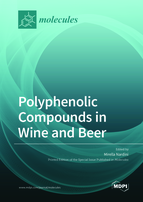Polyphenolic Compounds in Wine and Beer
A special issue of Molecules (ISSN 1420-3049). This special issue belongs to the section "Flavours and Fragrances".
Deadline for manuscript submissions: closed (30 November 2020) | Viewed by 39853
Special Issue Editor
Interests: biochemistry; food science; oxidative stress-related diseases; natural antioxidants; polyphenols
Special Issues, Collections and Topics in MDPI journals
Special Issue Information
Dear Colleagues,
Oxidative stress is involved in the pathology of many human diseases, such as atherosclerosis, diabetes, ageing, cancer, and neurodegenerative and cardiovascular diseases. Dietary antioxidants may offer protection against oxidative stress and counteract the onset and development of pathological conditions. Among dietary antioxidants, polyphenolic compounds are by far the most abundant in most human diets, being largely present in fruit and vegetables. Evidence from epidemiological studies suggest that the long-term consumption of polyphenol-rich foods afford protection against the development of cardiovascular and degenerative diseases, cancer, and diabetes. For individuals regularly consuming wine, beer, coffee, and tea, these beverages represent the main sources of dietary polyphenols. Polyphenol compounds from beer and wine are quickly absorbed and metabolized in humans. Moderate beer and wine consumption has been reported to exert a protective effect on human health, especially on cardiovascular risk factors.
This Special Issue aims to present manuscripts that cover the polyphenolic composition of wine and beer, with special emphasis on extractive and analytical aspects. Furthermore, particular interest will be given to the role of technological processes on the nutritional quality and polyphenol composition of wine and beers. Research studies and reviews dealing with the effects of wine and beer polyphenols in humans and in animal models are also welcome.
Dr. Mirella Nardini
Guest Editor
Manuscript Submission Information
Manuscripts should be submitted online at www.mdpi.com by registering and logging in to this website. Once you are registered, click here to go to the submission form. Manuscripts can be submitted until the deadline. All submissions that pass pre-check are peer-reviewed. Accepted papers will be published continuously in the journal (as soon as accepted) and will be listed together on the special issue website. Research articles, review articles as well as short communications are invited. For planned papers, a title and short abstract (about 100 words) can be sent to the Editorial Office for announcement on this website.
Submitted manuscripts should not have been published previously, nor be under consideration for publication elsewhere (except conference proceedings papers). All manuscripts are thoroughly refereed through a single-blind peer-review process. A guide for authors and other relevant information for submission of manuscripts is available on the Instructions for Authors page. Molecules is an international peer-reviewed open access semimonthly journal published by MDPI.
Please visit the Instructions for Authors page before submitting a manuscript. The Article Processing Charge (APC) for publication in this open access journal is 2700 CHF (Swiss Francs). Submitted papers should be well formatted and use good English. Authors may use MDPI's English editing service prior to publication or during author revisions.
Keywords
- wine
- beer
- polyphenols
- oxidative stress
- antioxidant activity







